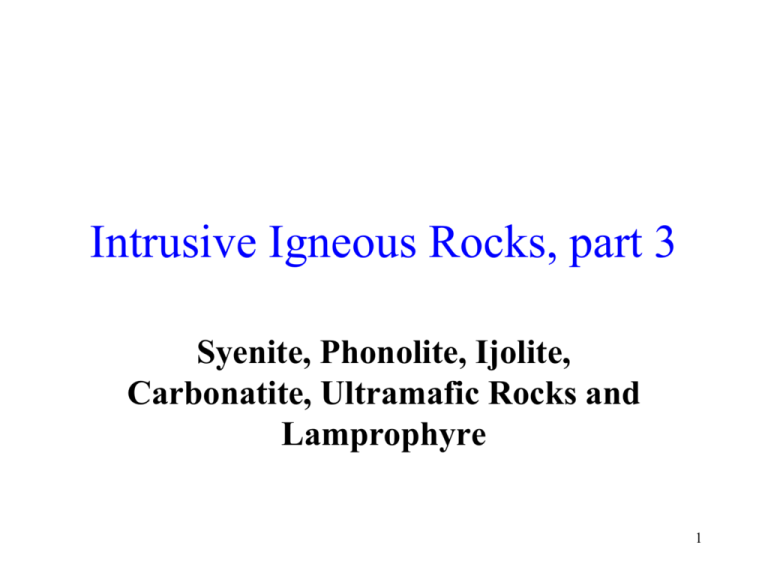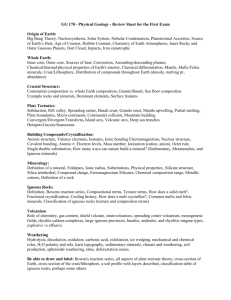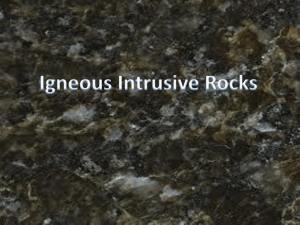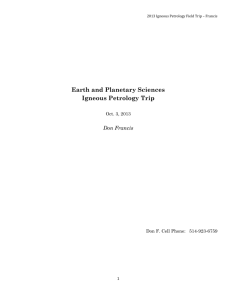Lab 8 - Syenite, Phonolite, Ijolite, Carbonatite, Ultramafic Rocks and
advertisement

Intrusive Igneous Rocks, part 3
Syenite, Phonolite, Ijolite,
Carbonatite, Ultramafic Rocks and
Lamprophyre
1
IUGS Intrusive Igneous Rock
Chart
2
General Intrusive Rocks Classification
3
Position on IUGS Diagram
• Syenites are on the border between the QAP and
the APF triangles
• The remaining rocks are in the APF triangle
• Phonolite is actually an extrusive or hypabyssal
equivalent of nepheline syenite
• The ultramafic rocks and lamprophyre are very
rich in mafic minerals
• Consequently they cannot be plotted on the main
part of the main IUGS diagram
• They plot on Figure2-2c (p. 27, Winter) in a
separatetriangle
4
Syenite
•
•
•
•
Intrusive igneous, plutonic
Q = 0-5
P/(A+P) is 10-35
Name is for Syene (near Aswan), Egypt - Pliny
the Elder named granite-like rocks from this area
for the locality
5
Syenite Mineralogy
• Major mineral is feldspar, with greater than 65%
alkali feldspar (K-spar or albite)
K-spar is typically orthoclase, microcline or perthite in dikes sanidine may be present
• The ferromagnesian minerals are usually < 20%
• Biotite is often present and is usually brown
6
Syenite Mineralogy
• Plagioclase, if present, is generally subhedral and
is often zoned (normal or oscillatory)
• Small amounts of feldspathoids, like nepheline
and sodalite, may be present - if more than 5% of
these minerals are present, the rock is called
nepheline (or sodalite) syenite
• Accessory minerals: Titanite, apatite, ilmenite,
magnetite, zircon, and monzonite
7
Syenite Photomicrograph
Perthite texture in twinned
alkali feldspar (perthite)
crystals in Syenite
[CN, medium power.]
• Process: Albite and K-spar are
mutually soluble in the
crystalline state to a limited
extent
• Mutual solubility is greater at
high temperature
• As a high-temperature K-rich
alkali feldspar cools past the
solvus into the two-feldspar
domain, the dissolved albite
exsolves to form irregular
lamellae of albite within the
potassium-feldspar host
(perthite)
8
Syenite Hand Specimen Photo
• K-feldspar megacrysts
• Pyroxene
• Location: Brenner
Pluton, Yukon
• Photo: James Lang
9
Alkali Syenite
• Intrusive igneous, plutonic
• Q = 0-5
• P/(A+P) is 0-10
10
Alkali Syenite Mineralogy
• A syenite rich in sodium, this rock has strongly
perthitic K-spars or anorthoclase
• Plagioclase is albite to sodic oligoclase.
• Mafic minerals include iron-rich biotite, iron or
sodic amphiboles including hastingsite,
arfvedsonite, or riebeckite, and pyroxene is either
aegirine-augite or aegirine.
• Accessory feldspathoids may be present
11
Nepheline Syenite
•
•
•
•
Intrusive igneous, plutonic
P/(A+P) is 10-35
F = 0-10
Foid syenite composed of granular aggregates,
typically orthoclase, microcline, microperthite,
cryptoperthite, or albite.
• Other essential felsics: nepheline
• Accessory feldspathoids: cancrinite, sodalite,
hauyne, or nosean
12
Mafic Minerals in Nepheline
Syenite
• Mafics are soda-rich
• Amphiboles arfvedsonite, or hastingsite
• Pyroxenes aegirine-augite, aegirine, or titanaugite
13
Nepheline Syenite Photomicrograph
• Large, simple-twinned
crystal of perthite (alkali
feldspar exhibiting wispy
exsolution lamellae)
• Equant, colorless crystals of
nepheline. The turbid areas
of the nepheline crystals are
Slide also shows green alkali where it has been altered to
pyroxene (bottom left,
sericite (fine-grained
interference color distorted
muscovite).
by green body color) and
altered biotite [CN, low
power]
14
Nephelinite
• Nephelinite (alkaline mafic
lava) consisting of equant,
low-birefringence crystals
of nepheline and euhedral
crystals of alkali pyroxene,
often showing zoning, set
in a glassy groundmass
• Presence of the
feldspathoid nepheline
indicates that the magma
was silica-undersaturated
• CN, medium power
15
Nephelinite
• Nephelinite (alkaline
mafic lava) consisting
of equant, sometimes
6-sided colorless
crystals of nepheline
and euhedral to
subhedral greenybrown crystals of
alkali pyroxene
• PP, medium power
16
Larvikite
• Intrusive igneous, plutonic
• Pearl gray alkali syenite, sometimes opalescent,
which grades into monzonite
• Typically coarse textured
• The name is for the locality, Larvik, Norway
17
Larvikite Mineralogy
• Prominent crystals are rhombs of very finely
twinned sodic-plagioclase and alkali feldspar
• Mafics are diopsidic augite and titanaugite
• Accessory apatite, ilmenite, titaniferous magnetite,
nepheline, olivine, or biotite
• Often used as a decorative stone because of a
beautiful opalescence when polished
18
Larvikite Polished Section Photo
• Polished surface on coarsegrained larvikite rock, a type of
syenite from Norway - widely
marketed under the trade name
'Blue Pearl'
• Composed mainly of large
crystals of alkali feldspar (K +
Na), with lesser amounts of dark
• The rock is particularly attractive minerals
because the feldspar cleavage
• The large crystal in middle of
surfaces (visible as bright areas in photo is about 2 centimeters
photo) show as pearly pale blue long, and shows a hint of
iridescent flashes
concentric growth layers
• Location: Larvik district,
southeast coast of Norway
19
Ijolite
•
•
•
•
•
Intrusive igneous, plutonic to hypabyssal
F = 60-100
M = 30-70
Sodium > potassium
The name is for the locality parish Ijo, Finland
20
Ijolite Mineralogy
• A feldspathoid-rich rock, containing essential
nepheline (50-70%)
• Essential: pyroxene, generally aegirine
• Ijolites, carbonatites, and syenites are often
associated, and are often rich in alkali elements
• The silicate and carbonatite minerals have similar
trace and minor element chemistries, including
high values of Ba, Sr, Ce, La, Zr, P, and Cl
• Frequent host rocks for rare-earth and apatite
minerals
21
Carbonatite
• Intrusive igneous, hypabyssal
• Igneous rock in which the carbonate minerals are
primary
• Apatite and pyrochlore are often considered
essential
• Accessory: Siderite, calcite, dolomite, or ankerite
• Less common accessory minerals: Mg-rich
magnetite, phlogopite, and pyrite
22
Carbonatite Occurrence
• Carbonatites occur as plugs with surface areas of
up to 8 km2.
• They are enclosed in mafic alkaline rings.
• Mafic rocks include biotite pyroxenite, ijolite,
nephelinite (35% nepheline, 65% mafic on
average), and jacupirangite (rocks consisting of
pure magnetite, magnetite with accessory
pyroxene, pyroxene with accessory magnetite, or
pyroxene and nepheline with biotite and olivine).
23
Carbonatite Origin
• The similarity between silicate and carbonate
phase trace and minor elements has convinced
most petrologists that the carbonatites must
originate together with the silicates, possibly from
the same source, and not from limestones, as
early workers had suggested
24
Extrusive Rock Classification
25
Phonolite
• Igneous extrusive, hypabyssal?
• The rock is usually a lava, but may occur in
shallow dikes
• Name, from the Gr. phone, meaning sound
Supposedly the rock rings when struck with a
hammer
• Other names are clinkstone and echodolite
26
Phonolite Mineralogy
• An aphanitic rock composed of alkali
feldspar, often anorthoclase or sanidine,
nepheline, and mafics
• Other feldspathoids may replace nepheline
27
Ultramafic Rocks
• Igneous intrusive, plutonic
• M 90
• Examples: dunite, peridotite, and pyroxenite
28
Ultramafic Classification Diagram
29
Mineralogy of Ultramafic Rocks
• Ultramafic rocks are composed of minerals near
the top of Bowen’s Reaction series
• These minerals, especially iron-rich varieties, are
prone to weathering.
• Serpentine minerals are common weathering
products of olivine or pyroxene
• Serpentine may be accompanied by talc, another
weathering product, or by magnesite, formed by
the precipitation of MgCO3 from sea-water after
the release of Mg ion
30
Mineralogical Changes in
Ultramafic Rocks
• Magnetite is a very common accessory mineral in felsic
to mafic rocks
• In ultramafic rocks, almost all of the iron is associated
with various mafic silicates minerals, so there is no iron
oxide phase present
• Opaque accessory mineral is often chromite
• If enough chromite is present, the rock may become an
ore of chromium
• In hand specimen, chromite is mostly easily seen in
fresh specimens of dunite
31
Mineralogical Changes in
Ultramafic Rocks
• Titanium is often present, and titanoaugites
or other titanium rich minerals may be
present
32
Pyroxenite
• Intrusive igneous, plutonic
• ol/(ol + cpx +opx) < 40%
• M 90
33
Pyroxenite Mineralogy
• Some pyroxenites contain more iron and are
predominantly composed of opx - either hypersthene
or bronzite
• Bronzite is named for the noticeable bronze
reflection (Schiller luster) that may be seen in hand
specimen.
• If clinopyroxene is present it is often the variety
diallage which shows well-developed parting
parallel to {100} in the augite-diopside composition
range.
• Ti-bearing augite or aegirine is also possible
34
Pyroxenite Mineralogy
• Accessory minerals include:
Hornblende, generally brown, may be present
Chromite - Crystals may be diamond or square
shaped - crystals in hand specimen are small,
seldom showing octahedral habit
35
Clinopyroxenite
• This rock is dominated
by the clinopyroxene
augite
• Location: West Point,
GA
36
Bronzitite
• Intrusive igneous, plutonic
• A type of pyroxenite composed almost exclusively
of bronzite
• Accessory minerals may include olivine, picotite
(chromian spinel), chromite, hornblende.
• Secondary serpentine may be present
• Also called bronzite
37
Bronzitite Photomicrograph
• Almost all of the grains in
this photomicrograph are
hypersthene
• This rock also contains
some interstitial
plagioclase, better seen in
plane light.
Location: Stillwater
Complex, Montana
38
Hypersthene Photomicrograph
• Orthopyroxenes are noted
for having low, first-order
interference colors
• Also note the cleavages
that intersect at about 90
degrees.
• Another identifying
characteristic of
orthopyroxene is its
parallel extinction.
39
Peridotite
•
•
•
•
Intrusive igneous, plutonic
ol/(ol + cpx +opx) > 40%
M 90%
The mineralogy is similar to the pyroxenites,
except that a mica, phlogopite, is often present
• The rock is feldspar free
• Name - from the French name for olivine, péridot
40
Dunite
• Dunite is olivine peridotite
• Ol > 90%
41
Dunite Photomicrograph
• Almost all of the
grains in this rock are
olivine - note the high
order interference
colors of olivine
• Secondary calcite
occurs as veinlets
through the sample
42
Harzburgite
• Intrusive igneous, plutonic
• Harzburgite is a type of peridotite in which the
major minerals are orthopyroxene (generally near
enstatite) and Mg-rich olivine.
• M 90%
• ol/(ol+opx+cpx) = 40-90
• cpx/(ol+opx+cpx) < 5%.
43
Harzburgite
• Harzburgite is believed to represent
depleted mantle material after the removal
of a basaltic component
• Name - for the locality, Harzburg, Germany
44
Chromitite
• Intrusive igneous, plutonic
• Igneous rock composed of 95%+ of chromite
• Similar rocks with larger percentages of
ferromagnesian minerals may be named for the
mineral, e.g. olivine chromitite
• Rock is denser than most other ultramafic rocks
45
Hornblendite
• Intrusive igneous, plutonic
• M 90%
• hb/(hb+px+ol) > 90%
46
Kimberlite
• Potassium-rich peridotites which usually occur as
“pipes” which originate in the mantle
• Usually have an abundant volatile content, especially
CO2 and H2O
• Found in old (>2500 my), stable continental areas but
are themselves much younger, often Mesozoic in age
• Kimberlite magmas intrude along deep fractures,
sometimes extensions of ocean fracture zones
• Name - for the locality Kimberly, South Africa
47
Kimberlite Xenoliths
• Kimberlites are most interesting scientifically
because they carry a rich variety of xenoliths and
xenocrysts
• Many are these xenoliths are believed to be part of
the mantle or deep crust
They are pieces that fell into the kimberlite magma
during its passage to the surface
• Xenoliths include garnet peridotites, lherzolites,
and eclogites, which are believed to be samples of
the mantle lithosphere and even the upper
asthenosphere
48
Kimberlite Mineralogical
Alteration
• Kimberlites often show signs of alteration
• Olivine is transformed to serpentine, usually
antigorite
• Phlogopite is transformed to chlorite, or
vermiculite, with accompanying magnetite
and/or calcite
49
Kimberlite breccia
• Kimberlites may also occur as breccia
This probably represents turbulent
emplacement, where the magma is mixed with
many different kinds of xenoliths
• Xenoliths from depth are rounded, probably
as the result of wear during the ascent, and
the upper xenoliths are more angular
50
Kimberlite Composition
• Intrusive igneous, dike or pipe
• Kimberlite is a porphyritic peridotite or peridotite
breccia
• Essential: Olivine, usually altered to serpentine,
and phlogopite (commonly chloritized)
• Accessory: carbonates
• Groundmass is usually calcite, serpentine, chlorite,
phlogopite and accessory minerals such as
chromian pyrope, ilmenite, magnetite, and
perovskite
51
Lherzolite Photomicrograph
• The picture shows
olivine (right side of
picture), orthopyroxene
(lower left) and
clinopyroxene (upper
left)
• Lherzolites contain over
60% olivine, and some
• Lherzolite is a major constituent clinopyroxene and
of the mantle and the source
orthopyroxene
of most basaltic magmas.
52
Lamprophyre
• Lamprophyre chemical composition is very
similar to that of alkaline olivine basalt
• Lamprophyres are widespread but volumetrically
insignificant rocks
• Occurrence: As dikes, often cutting granitic
batholiths or stocks - dikes may be radiating or
may form a dike swarm of sub-parallel dikes
• Dikes are small - a few meters, at most, thick, but
may be miles long
53
Lamprophyre Composition
• Fine-grained, dark-colored, often containing
mafic phenocrysts, but never felsic
phenocrysts
• Groundmass is predominantly felsic and may
include plagioclase, nepheline, sanidine,
melalilite ([(Na,Ca)2(Mg,Al)(Al,Si)2O7], and
analcite (NaAlSi2O6.H2O), a zeolite
• Xenoliths of country rock are common
54
Lamprophyre Parent Rock
• Parent material of lamprophyres is probably alkaline
olivine basalt
• Movement of alkaline olivine basalt magma toward
the surface might induce decompressive melting, and
the resulting magma could be injected into fractures
resulting from compressive failure
• Mafic phenocrysts would have formed early, before
injection
55
Lamprophyre Composition
• Intrusive igneous, diaschist
• Lamprophyre rocks are melanocratic or mesotype
hypabyssal rocks
• Mafic phenocrysts occur in a fine-grained
groundmass
• Name, from the Greek lampros, meaning bright, in
allusion to the bright reflection from biotite
phenocrysts found in some lamprophyres
56
Lamprophyre Mineralogy
• Mafic minerals are olivine (or serpentine), biotite,
hornblende (usually green), and pyroxene (green
diopside or Fe-Ti augite, which is purplish)
• Felsic minerals are often alkaline, such as alkali
feldspar (K-spar or albite) and Na-rich nepheline
• Plagioclase is common, while quartz may be
present
• Often associated with carbonatites
57
Nepheline Diorite Lamprophyre
• Intrusive igneous, diaschist
• A dioritic lamprophyre is one in which the
major feldspar is plagioclase
• In addition this rock contains the
feldspathoid nepheline
58
Lamprophyre Photomicrograph
• Lamprophyre (alkaline mafic dike-rock) with
microphenocrysts of biotite and pyroxene
• CN
59






